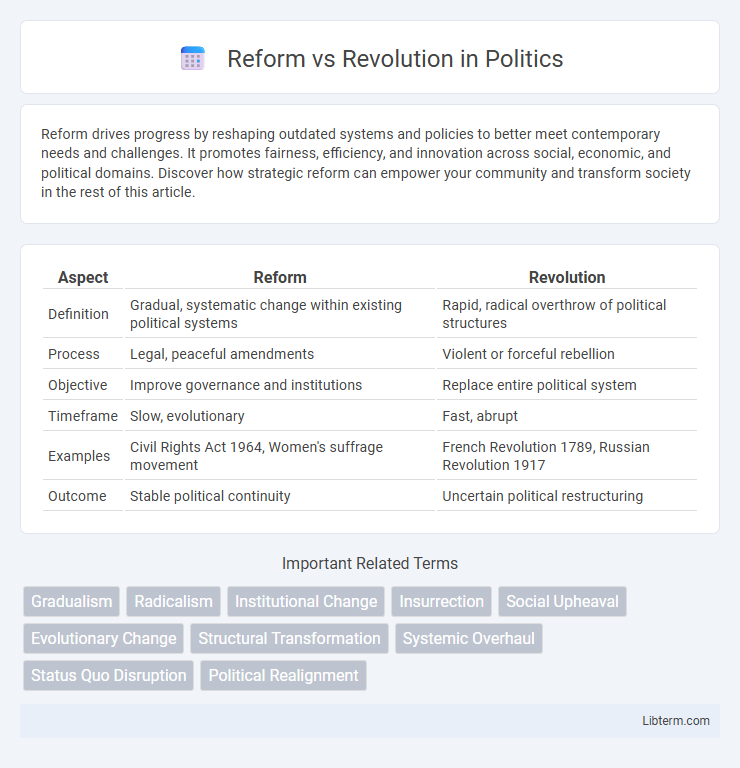Reform drives progress by reshaping outdated systems and policies to better meet contemporary needs and challenges. It promotes fairness, efficiency, and innovation across social, economic, and political domains. Discover how strategic reform can empower your community and transform society in the rest of this article.
Table of Comparison
| Aspect | Reform | Revolution |
|---|---|---|
| Definition | Gradual, systematic change within existing political systems | Rapid, radical overthrow of political structures |
| Process | Legal, peaceful amendments | Violent or forceful rebellion |
| Objective | Improve governance and institutions | Replace entire political system |
| Timeframe | Slow, evolutionary | Fast, abrupt |
| Examples | Civil Rights Act 1964, Women's suffrage movement | French Revolution 1789, Russian Revolution 1917 |
| Outcome | Stable political continuity | Uncertain political restructuring |
Understanding Reform and Revolution
Reform involves gradual changes within existing political and social structures aimed at improving systems without overthrowing them, often pursued through legal and institutional processes. Revolution denotes a rapid and fundamental transformation of society by dismantling current systems, frequently accompanied by widespread social upheaval and radical shifts in power. Understanding reform and revolution requires recognizing their differing approaches to change: reform preserves core frameworks, while revolution seeks to replace them entirely.
Historical Contexts of Reform and Revolution
Reform movements historically emerged within existing political frameworks aiming for gradual improvements, as seen in the British Reform Acts (1832-1884) that expanded suffrage incrementally. Revolutions, such as the French Revolution (1789-1799), represented abrupt, radical shifts overthrowing established regimes to reconstruct political and social orders. The contrasting historical contexts highlight reforms as evolutionary processes responding to systemic pressures, while revolutions signify revolutionary ruptures driven by deep social grievances and demands for comprehensive change.
Key Differences Between Reform and Revolution
Reform involves gradual, legal changes within an existing political or social framework, aiming to improve structures without overthrowing them. Revolution denotes a rapid, often violent upheaval that completely replaces existing systems with new governance or societal order. Key differences include the pace, method, and extent of change--reforms are evolutionary and typically peaceful, while revolutions are radical and disruptive.
Motivations Behind Reform Movements
Reform movements are primarily motivated by the desire to address specific social, political, or economic issues through gradual change within existing systems. These movements seek to improve conditions such as labor rights, education, or civil liberties without dismantling the entire government structure. Key drivers include public dissatisfaction with injustice, inequality, and ineffective policies that hinder progress.
Factors Driving Revolutionary Change
Economic inequality, political oppression, and social injustice act as primary catalysts fueling revolutionary change, as marginalized groups demand systemic transformation rather than incremental reform. Revolutionary movements often gain momentum through widespread discontent triggered by acute crises such as financial collapse, military defeat, or severe government corruption. The failure of reform efforts to address deep-rooted grievances intensifies revolutionary fervor, pushing populations toward radical upheaval and the complete overhaul of existing institutions.
Advantages and Disadvantages of Reform
Reform offers the advantage of gradual change, allowing existing institutions to adapt without causing social upheaval or economic instability. It often leads to more sustainable improvement by building consensus and minimizing resistance from stakeholders. However, reforms can be slow, sometimes insufficient to address urgent systemic problems, and may be co-opted by entrenched interests, limiting their effectiveness.
Pros and Cons of Revolutionary Approaches
Revolutionary approaches can rapidly dismantle entrenched systems, enabling swift and radical social, political, or economic change that reforms alone may fail to achieve. However, revolutions often carry significant risks, including widespread violence, instability, and the potential for power vacuums that may lead to authoritarian regimes or prolonged conflict. The unpredictability and high cost of revolutionary upheaval pose challenges to sustainable progress and long-term social cohesion.
Case Studies: Successes and Failures
Reform efforts in countries like Sweden and Germany demonstrate success through gradual policy changes within existing political frameworks, fostering stable economic growth and social equity. Conversely, revolutionary movements such as the Russian Revolution of 1917 and the Arab Spring reveal mixed outcomes where initial overthrow of regimes led to either authoritarian resurgence or prolonged instability. Case studies highlight that reforms tend to succeed when embedded in institutional adaptability, whereas revolutions often result in unpredictable power vacuums and long-term societal disruption.
Social and Political Impacts
Reform initiates gradual social and political change by modifying existing institutions, often enhancing stability and reducing conflict through legal and policy adjustments. Revolution triggers rapid, fundamental transformations in societal and governmental structures, frequently leading to upheaval, power shifts, and widespread redefinition of social norms. Both processes reshape citizenship rights, governance models, and societal hierarchies, but revolutions typically produce more radical and immediate impacts compared to the incremental effects of reforms.
Choosing Between Reform and Revolution
Choosing between reform and revolution involves weighing gradual change against radical overhaul to achieve political or social goals. Reform allows for incremental improvements within existing systems, reducing risks of instability, while revolution seeks complete transformation, often accompanied by higher uncertainty and conflict. Decision-making depends on factors like urgency of issues, level of public support, and willingness of power structures to adapt.
Reform Infographic

 libterm.com
libterm.com